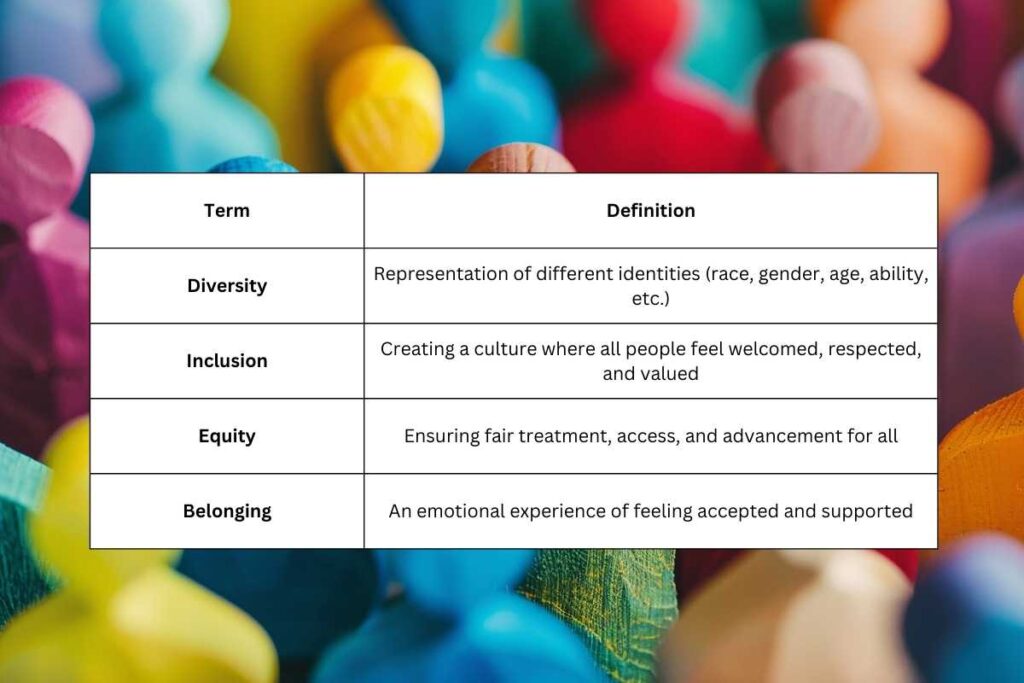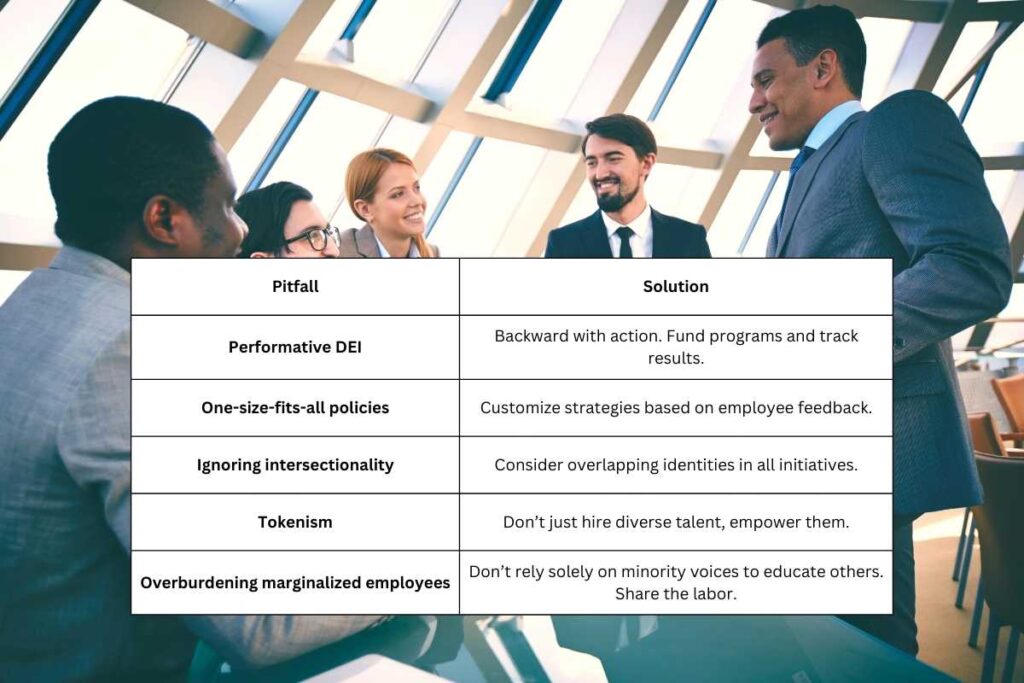Inclusion is a Culture, Not a Checkbox
In today’s global, interconnected world, diversity and inclusion are no longer just HR buzzwords; they are business imperatives. Yet, despite a surge of corporate pledges and polished diversity statements, many organizations still struggle to translate inclusive ideals into everyday reality.
True inclusion goes beyond hiring quotas and diversity metrics; it means creating a culture where everyone feels respected, valued, and empowered to contribute. It’s about moving from performative gestures to intentional actions. In this article, we explore how organizations can build inclusive workplaces by bridging the gap between policy and practice, driving not just compliance but belonging, innovation, and sustainable success.
1. Why Inclusion Matters More Than Ever
The Business Case for Inclusion
- Improved Innovation: Diverse teams are 35% more likely to outperform competitors due to varied perspectives.
- Higher Employee Engagement: Inclusive cultures see 2.3x higher cash flow per employee.
- Talent Attraction and Retention: Top talent today prioritizes inclusive and equitable environments.
- Stronger Reputation: Brands that champion inclusion gain consumer trust and loyalty.
In short, inclusion is not just the right thing to do, it’s also strategically smart.
2. From Diversity to Inclusion: Understanding the Difference
Diversity is about who is at the table. Inclusion is about who gets to speak and be heard. A company can be diverse on paper and still exclusive in practice.

| Term | Definition |
| Diversity | Representation of different identities (race, gender, age, ability, etc.) |
| Inclusion | Creating a culture where all people feel welcomed, respected, and valued |
| Equity | Ensuring fair treatment, access, and advancement for all |
| Belonging | An emotional experience of feeling accepted and supported |
Building an inclusive workplace involves intentionally designing systems and behaviors that foster equity, representation, and respect at every level.
3. Laying the Groundwork: Inclusive Policies That Matter
Before culture can flourish, there must be clear policies that reflect inclusive values.
Key Inclusive Policies to Implement:
- Anti-Discrimination and Harassment Policies
– Zero tolerance for racism, sexism, ableism, and bias-driven behaviors
– Clear procedures for reporting and resolving grievances - Inclusive Hiring Practices
– Standardized, bias-reduced interview processes
– Job descriptions free from gendered or exclusionary language - Equity in Pay and Promotions
– Regular audits to identify wage gaps
– Transparent performance and promotion criteria - Parental Leave and Caregiver Support
– Paid family leave policies that support all parents
– Flexibility for caregiving and family emergencies - Accessibility and Accommodations
– Workplace design that supports employees with disabilities
– Flexible work arrangements and assistive technologies - LGBTQ+ Inclusive Benefits
– Health benefits that include same-sex partners and gender-affirming care
– Use of inclusive language in all company materials
Tip: Inclusion isn’t static. Regularly review and update policies to reflect evolving needs and legal standards.
4. Embedding Inclusion into Daily Workplace Practices
Policies are only effective when brought to life through daily behavior and culture.
Leadership Commitment
Inclusion must be modeled from the top. Leaders must:
- Publicly advocate for inclusive values
- Participate in training and development
- Hold themselves accountable for inclusion outcomes
Example: CEOs who share their commitment to DEI in all-hands meetings help set the tone for the entire company.
Inclusive Meetings
- Rotate who leads and speaks
- Use structured agendas to avoid dominance by a few voices
- Ensure accessibility for all participants (e.g., captions, quiet spaces, visual aids)
Inclusive Language
Words matter. Adopt language that:
- Respects gender identity (e.g., use pronouns in email signatures)
- Avoids assumptions (e.g., using “partner” instead of “husband/wife”)
- Is mindful of neurodiversity and cultural differences
Allyship in Action
- Encourage bystander intervention in cases of bias
- Promote mentoring programs that pair diverse employees with senior leaders
- Celebrate cultural and identity milestones (e.g., Pride Month, Black History Month, Eid)
Inclusive Culture = Consistent Actions + Reinforced Norms
5. Training with Intent: Moving Beyond the Basics
While unconscious bias training is common, it’s not enough on its own. Effective DEI education should be:

- Ongoing, not a one-off workshop
- Interactive, encouraging reflection and dialogue
- Tailored to specific roles and industries
- Measured, with feedback and follow-up actions
Advanced Topics to Consider:
- Intersectionality in the workplace
- Power dynamics and privilege
- Inclusive leadership and feedback
- Trauma-informed management
Pro Tip: Invite lived experiences into training. Listening to real stories can shift mindsets more than any slideshow.
6. Measuring Inclusion: Metrics That Matter
You can’t improve what you don’t measure. Go beyond headcount and track true inclusion indicators:
Quantitative Metrics:
- Representation across levels (entry to executive)
- Pay equity analysis
- Promotion and attrition rates by demographic
- Participation in leadership development programs
Qualitative Insights:
- Employee engagement surveys with inclusion-specific questions
- Focus groups and listening sessions
- Psychological safety assessments
- Exit interview themes
Warning: Metrics without context can be misleading. Pair numbers with a narrative to understand what’s happening.
7. Technology’s Role in Building Inclusion
Today’s digital tools can support inclusive practices when used thoughtfully:
- AI in Hiring: Screen for bias, not reinforce it. Use diverse datasets and audit algorithms regularly.
- Internal Platforms: Create safe spaces for employee resource groups (ERGs) and community conversations.
- HR Analytics: Use dashboards to monitor inclusion metrics and highlight areas of concern.
Example: Tools like Textio help HR teams write job ads with inclusive language that attracts diverse candidates.
8. Employee Resource Groups: Grassroots Inclusion Builders
ERGs, voluntary, employee-led groups, can be powerful drivers of inclusion and belonging. Examples include:
- Women in Leadership
- Black Professionals Network
- LGBTQ+ Alliance
- Mental Health Advocates
- Veterans at Work
Benefits of ERGs:
- Create safe spaces for dialogue
- Advise leadership on inclusion strategies
- Foster cross-functional collaboration
- Provide leadership development opportunities
Support ERGs with budgets, executive sponsorship, and visibility.
9. Inclusive Remote and Hybrid Workplaces
With remote work on the rise, inclusion needs to be reimagined for distributed teams.
Strategies for Remote Inclusion:
- Offer flexible scheduling across time zones
- Ensure virtual meetings are accessible (captioning, screen reader-compatible tools)
- Be sensitive to digital burnout and mental health
- Create virtual social spaces for informal connection
Challenge: Avoid proximity bias, don’t favor in-office employees over remote ones when it comes to promotions or visibility.
10. From Policy to Culture: The Role of Leadership and Accountability
Ultimately, inclusion succeeds when leaders live the values and hold themselves accountable.
Leadership Actions that Drive Inclusion:
- Publicly set and report DEI goals
- Sponsor diverse talent for high-visibility roles
- Tie bonuses or KPIs to inclusive behavior
- Conduct “inclusive leadership” 360 reviews
- Respond swiftly to microaggressions or bias incidents
Tip: Create an Inclusion Council with members across departments and levels to guide strategy and accountability.
11. Common Pitfalls and How to Avoid Them

| Pitfall | Solution |
| Performative DEI | Backward with action. Fund programs and track results. |
| One-size-fits-all policies | Customize strategies based on employee feedback. |
| Ignoring intersectionality | Consider overlapping identities in all initiatives. |
| Tokenism | Don’t just hire diverse talent, empower them. |
| Overburdening marginalized employees | Don’t rely solely on minority voices to educate others. Share the labor. |
Inclusion is a shared responsibility, not just for HR but for everyone.
12. The Future of Inclusive Workplaces: What’s Next?
The most progressive companies are now moving toward:
- Justice-centered workplaces, focused on dismantling systemic barriers
- Neurodiverse-friendly cultures that support cognitive differences
- Global inclusion strategies, addressing regional nuances
- Employee activism, where staff push companies to walk the talk
- Ethical AI and tech equity, ensuring innovations don’t reinforce bias
As workforces evolve, so must the strategies to support them. Inclusion is no longer optional, it’s the foundation of a future-ready workplace.
Conclusion: Inclusion Is a Daily Practice, Not a Policy Manual
Building an inclusive workplace is not a destination, it’s a journey of continuous learning, listening, and action. From thoughtful policies to everyday behaviors, inclusion must be intentional, accountable, and rooted in empathy.
True inclusion creates workplaces where people don’t just survive, they thrive. Where differences are celebrated, not merely tolerated. Where innovation, engagement, and impact are born from belonging.
Whether you’re a CEO, manager, or new hire, your actions matter. Because culture isn’t built by statements on a wall, it’s built by what we say, do, and reinforce every day.
So let’s stop talking about inclusion and start practicing it. One policy, one conversation, one act of allyship at a time.
